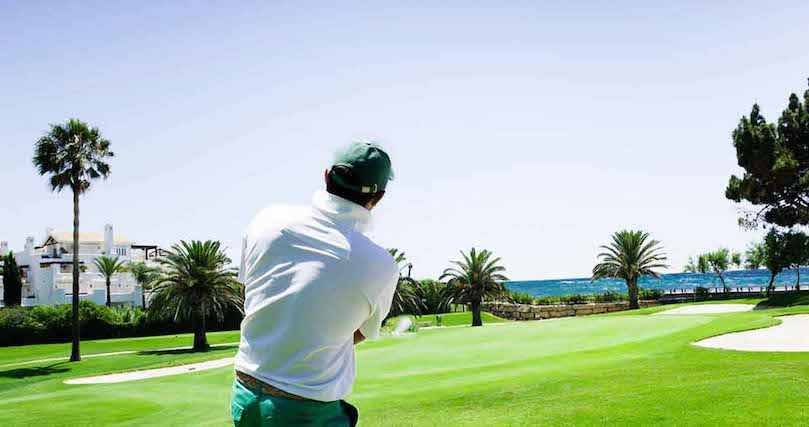Why we love Mijas
Mijas is a town of two different halves, separated by the main coast road. High up in the mountains you have Mijas Pueblo, arguably the most well-known traditional ‘white’ village in Spain, and on the other side there is Mijas Costa which includes Cabopino, Riviera del Sol, Miraflores and Calahonda. Located around 20 minutes to the west of Malaga, both parts are popular residential and holiday destinations, for different reasons, to a wide mix of nationalities.
Mijas Pueblo is often regarded as a jewel on the Costa del Sol, Mijas Pueblo is famous for its picture postcard prettiness, fiestas and festivals, also whether you love or loath them, for its traditional donkey taxis. From its elevated position the village also enjoys some extraordinary views across the Mediterranean and the surrounding landscapes.
What’s it like?
Mijas Pueblo is a magnet for expats attracted by the impossibly quaint cobbled streets, white washed properties and the traditional ambience. And in spite of the daily influx of tourists the village has in managed to retain its character and achieve a good balance of the old and new.
Improbable as it may seem, Mijas Pueblo is the venue for annual blues festival held in the central plaza. A free festival organised jointly by London club ‘Aint Nothin but the Blues’ and the Mijas Town Hall that attracts well-known international bluesmen.
History seems to unfold around every corner, from the Church of the Immaculate Conception built on the ruins of a 17th century castle using the original turrets as the bell tower or ‘The Grotto of the Virgin de la Peña the beautiful grotto believed to be the site where two local children saw an apparition the Virgin Mary in 1536. Today it attracts pilgrims from all over the world. At the heart of the village you find the bullring which is now 100 years old. Bullfights are usually held every weekend during the summer. Just look for the colourful posters dotted around the town.
One of the most famous attractions has to be the Mijas Wine Museum, where you can sample a selection of Spanish wines – cava, red, white, rose, sweet wine – and learn about the different influences, methods of production and flavours. You can also get advice about pairing wines with the right foods from professional oenologists.
Attractions
In fact Saturdays are a good day to visit during the summer, when the Foreigner’s Department of the local council offer free guided walks of the rural areas of the town beginning at 10am at the town hall (advance booking recommended).
Eating and drinking
You will never go hungry in Mijas Pueblo, there’s a café, bar or restaurant on almost every corner, with something for every taste and pocket. Grilled fish, fresh seafood, paella and the tantalising aroma of Moroccan spices, which isn’t surprising considering southern Spain’s proximity to North Africa. There is of course the option of Indian cuisine too.
Mirlo Blanco, situated in the main plaza, is the one of the most famous restaurants. Specialising in Basque cuisine, it has the whole gamut from steaks to offal cooked in a million and one ways, plus a good selection of wines.
Nightlife
Although thriving and very busy, Mijas Pueblo is essentially an upmarket village, so nightlife comprises mainly of restaurants and bars. If you’re expecting raucous nightlife and clubs you’ll need to travel to Mijas Costa or further along the coast to the neighbouring towns of Benalmádena, Fuengirola and Torremolinos or Malaga, where you’ll find cinema’s playing original version films, casinos, clubs theatres and of course thousands of restaurants and bars.
Shopping
There are plenty of opportunities to pick up local crafts, leather goods and bits and bobs from a number of local shops and supermarkets which are often open until late. On Saturday morning, there’s a farmers’ market offers a good selection of locally produced fruit, vegetables fresh meat and fish. You can also pick up herbs and spices, fresh bread and wine.
Sports and outdoor activities
Rock climbing
Inside the botanical gardens, you’ll find Parque Muralla a rock face specifically adapted for rock climbing. If you prefer to take a walk, the gardens are quite lovely and have amazing coastal views.
Walking & hiking
If you like walking and hiking, there are several well signposted routes of varying difficulty behind the village (free maps are available from the local tourist office). Or you can head slightly out of town towards the pine forests in Osanillas.
Golf courses in Mijas
Golf is one of the most, if not the most popular sports on the Costa del Sol and there is plenty of opportunity to play, practice and compete in the courses around Mijas.
- La Cala -Three 18-hole golf courses, golf academy, spa and much more
- Miraflores – 18-holes, academy, driving range and club house
- Calanova Golf – 18-holes, 5 minutes from the sea
- Cabopino –18-holes, academy, restaurant
- Siesta Golf– 9-holes chipping and putting, clubhouse, restaurant and tournaments
- Chaparral Golf– golf academy, club house, restaurant, instructors
Beaches close to Mijas Pueblo
Mija Pueblos’s hillside location means that it isn’t on the coast but it is in easy reach of the many beaches along the 12 metres of coastline known as Mijas Costa. The beaches along this stretch of the coast are generally flat, sandy with a smattering of coves, with lifeguards keeping watch throughout the summer, and safe for children. Most have a European Blue Flag, rating for cleanliness and quality of the sand. The number of beaches, small and large is surprising.
La Cala de Mijas
- Playa La Cala: One of the most popular, with all types of facilities including sunbeds, restaurants and disabled access. It also has the prestigious EU Blue Flag.
- Playa El Bombo: Flat sandy beach perfect for swimming (no stones at all!) There are 4 restaurants, sunbeds and also disabled access.
- Butiplaya: Ideal for swimming, sand without stones.
- Playa Las Doradas: A narrow strip of fine sand with a few stones and rocks. There is one restaurant and you can rent sun loungers.
- Playa El Chaparral: Situated between La Cala de Mijas and El Faro, this beach has fine sand and the seabed is a mixture of sand and rocks. There are no beach restaurants on Playa Chaparral.
Calahona
- Playa La Luna: The beach has dark fine sand with some rocks and has been awarded an EU Blue Flag. There’s one restaurant and sunbeds are available for rent.
- Playa el Almirante, Doña Lola Beach and Playa el Charcón: These beaches are similar, each with dark sand and some rocks, one restaurant and sunbeds for rent.
- Playa Peñón del Cura: Fairly narrow stretch of sand with pebbles and rocks on the seabed. Not the best beach for swimming.
Riviera
- Playa Riviera: This is Mijas Costa’s longest beach. It has the fine dark sand but there are rocks on the seabed. Sunbeds are available for rent and there are two restaurants
Miraflores
- Playa Cabo Rocoso: Thin strip of sand interspersed with small pebbles and a mixture of sand and rocks in the water. Sunbeds are available and there is a chiringito.
Mijas Costa/ Fuengirola
- Playa Faro de Calaburras: Similar to the other beaches in the area it is blessed with lovely fine sand, with a few rocks and pebbles in the water. There are plenty of sunbeds for rent and a restaurant on hand.
- Playa El Ejido: Fine sandy beach, seabed mixture of sand and rocks. One beach restaurant with sun loungers available to rent.
- Playa Marina: Long and pebbly, with a few rocks in the water, so it’s not ideal for swimming
Facts & Figures
Private schools close to Mijas
The Benalmadena International College– Benalmadena
Sunny View School – Torremolinos
St. Anthony’s College– Mijas Costa
How to get there
Mijas is just 22km west from Malaga airport. If travelling by car take the A-7 road, also known as Autovia del Mediterraneo.
Transport links
Mijas is very well connected by public transport. With buses and coaches run by Portillo Avanza.Buses run from Alhaurin el Grande, Arroyo de la Miel, Benalmadena Costa, Benalmadena Pueblo, Coín, Malaga, Torremolinos and Fuengirola.
Airports:
- 25 minutes from Malaga airport by car
- 1 hour from Gibraltar airport by car
- 2.5 hours from Jerez airport by car


